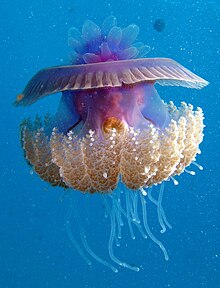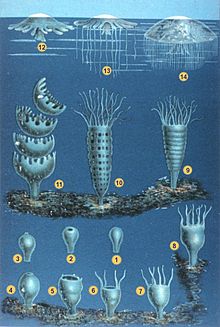
Cnidaria is a phylum under kingdom Animalia containing over 11,000 species of aquatic animals found both in fresh water and marine environments, including jellyfish, hydroids, sea anemones, corals and some of the smallest marine parasites. Their distinguishing features are a decentralized nervous system distributed throughout a gelatinous body and the presence of cnidocytes or cnidoblasts, specialized cells with ejectable flagella used mainly for envenomation and capturing prey. Their bodies consist of mesoglea, a non-living, jelly-like substance, sandwiched between two layers of epithelium that are mostly one cell thick. Cnidarians are also some of the only animals that can reproduce both sexually and asexually.

Jellyfish, also known as sea jellies, are the medusa-phase of certain gelatinous members of the subphylum Medusozoa, which is a major part of the phylum Cnidaria.

Aurelia aurita is a species of the family Ulmaridae. All species in the genus are very similar, and it is difficult to identify Aurelia medusae without genetic sampling; most of what follows applies equally to all species of the genus.

Hydrozoa is a taxonomic class of individually very small, predatory animals, some solitary and some colonial, most of which inhabit saline water. The colonies of the colonial species can be large, and in some cases the specialized individual animals cannot survive outside the colony. A few genera within this class live in freshwater habitats. Hydrozoans are related to jellyfish and corals and belong to the phylum Cnidaria.

Rhizostomeae is an order of jellyfish. Species of this order have neither tentacles nor other structures at the bell's edges. Instead, they have eight highly branched oral arms, along which there are suctorial minimouth orifices. These oral arms become fused as they approach the central part of the jellyfish. The mouth of the animal is also subdivided into minute pores that are linked to coelenteron.

Medusozoa is a clade in the phylum Cnidaria, and is often considered a subphylum. It includes the classes Hydrozoa, Scyphozoa, Staurozoa and Cubozoa, and possibly the parasitic Polypodiozoa. Medusozoans are distinguished by having a medusa stage in their often complex life cycle, a medusa typically being an umbrella-shaped body with stinging tentacles around the edge. With the exception of some Hydrozoa, all are called jellyfish in their free-swimming medusa phase.

Semaeostomeae is an order of large jellyfish characterized by four long, frilly oral arms flanking their quadrate mouths. The umbrella is domed with scalloped margins, and the gastrovascular system consists of four unbranched pouches radiating outwards from the central stomach; no ring canal is present. They usually possess eight tentacles; four are per-radical and four are inter-radical.

Pelagia noctiluca is a jellyfish in the family Pelagiidae and the only currently recognized species in the genus Pelagia. It is typically known in English as the mauve stinger, but other common names are purple-striped jelly, purple stinger, purple people eater, purple jellyfish, luminous jellyfish and night-light jellyfish. In Greek, pelagia means "(she) of the sea", from pelagos "sea, open sea"; in Latin noctiluca is the combining form of nox, "night"", and lux, "light"; thus, Pelagia noctiluca can be described as a marine organism with the ability to glow in the dark (bioluminescence). It is found worldwide in tropical and warm temperate seas, although it is suspected that records outside the North Atlantic region, which includes the Mediterranean and Gulf of Mexico, represent closely related but currently unrecognized species.
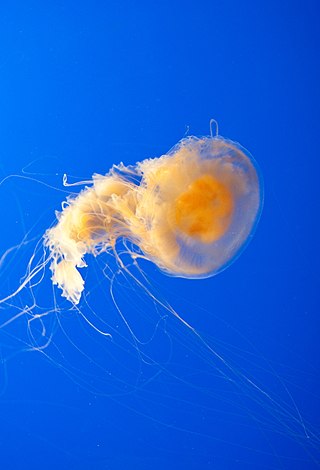
Phacellophora camtschatica, commonly known as the fried egg jellyfish or egg-yolk jellyfish, is a very large jellyfish in the family Phacellophoridae. This species can be easily identified by the yellow coloration in the center of its body which closely resembles an egg yolk, hence its common name. Some individuals can have a bell close to 60 cm (2 ft) in diameter, and most individuals have 16 clusters of up to a few dozen tentacles, each up to 6 m (20 ft) long. A smaller jellyfish, Cotylorhiza tuberculata, typically found in warmer water, particularly in the Mediterranean Sea, is also popularly called a fried egg jellyfish. Also, P. camtschatica is sometimes confused with the Lion's mane jellyfish.
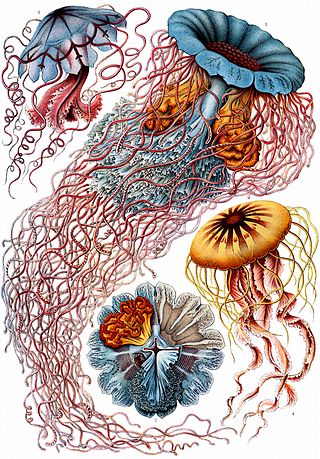
Discomedusae is a subclass of jellyfish in the class Scyphozoa. It is the sister taxon of Coronamedusae. Discomedusae contains about 155 named species and there are likely to be many more as yet undescribed. Jellyfish in this subclass are much more likely to have swarming events or form blooms than those in Coronamedusae. Discomedusae consists of two orders, Rhizostomeae and Semaeostomeae.

Cotylorhiza tuberculata is a species of jellyfish of the phylum Cnidaria, also known as the Mediterranean jellyfish, Mediterranean jelly, or fried egg jellyfish. It is commonly found in the Mediterranean Sea, Aegean Sea, and Adriatic Sea.

Turritopsis dohrnii, also known as the immortal jellyfish, is a species of small, biologically immortal jellyfish found worldwide in temperate to tropic waters. It is one of the few known cases of animals capable of reverting completely to a sexually immature, colonial stage after having reached sexual maturity as a solitary individual. Others include the jellyfish Laodicea undulata and species of the genus Aurelia.

Chrysaora hysoscella, the compass jellyfish, is a common species of jellyfish that inhabits coastal waters in temperate regions of the northeastern Atlantic Ocean, including the North Sea and Mediterranean Sea. In the past it was also recorded in the southeastern Atlantic, including South Africa, but this was caused by confusion with close relatives; C. africana, C. fulgida and an undescribed species tentatively referred to as "C. agulhensis".

Catostylus mosaicus is also known as the Jelly blubber or Blue blubber jellyfish. The jelly blubber is distinguishable by its color, which ranges from light blue to a dark blue or purple, and its large (250-300mm), rounded bell which pulses in a staccato rhythm. It occurs along the coastline of Eastern Australia in estuaries and shallow bays, and often blooms to high abundance.
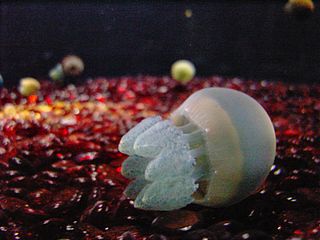
Catostylidae is a family of jellyfish, their common name is fat-armed jellies. Members of this family are characterized by their thick, sausage-like oral arms. Members of the family Catostylidae are small marine jellyfish with domed bells. The eight short oral arms are broad and three-sided. These jellies do sting but usually only leave minor burns.

The helmet jellyfish, sometimes called the merchant-cap, is a luminescent, red-colored jellyfish of the deep sea, belonging to the order Coronatae of the phylum Cnidaria. It is the only species in the monotypic genus Periphylla and is one of the rare examples in Scyphozoa which life-cycle lacks a polyp stage. This species is photophobic and inhabits deeper parts of the oceans to avoid light. It may be found at the surface on dark nights.

The thimble jellyfish is a species of cnidarian found in the warm West Atlantic Ocean, including the Caribbean. It is a tiny jellyfish with a straight-sided, flat-topped bell. This jellyfish is the most common cause of seabather's eruption, a reaction caused by the injection of juvenile jellyfish nematocysts into human skin.

Rhopilema verrilli, or mushroom cap jellyfish, is a species of jellyfish in the family Rhizostomatidae. They are cnidarian invertebrates distinguished by their mushroom-shaped medusae. The species does not have any tentacles; however, they still have stinging cells, called nematocysts, within their bells, which can produce mild stings to humans.

Cyanea annaskala is a species of jellyfish that was discovered in 1882 by Robert Lendlmayer von Lendenfeld.

Desmonema is a genus of jellyfish under the Cyaneidae family found in colder waters near the Antarctic region and off of the coast of Argentina. They have a bell diameter that can extend over 1 meter and wide tentacles that are grouped together in clusters. They share similar anatomical and physiological structures to the genus Cyanea. Their sophisticated structures like the thick tentacles, sensory systems, and gastrovascular system allow Desmonema to easily capture and extracellularly digest their prey. In recent years, Desmonema were reported to have a commensal relationship with fishes under the Trachurus genus and a parasitic relationship with specimens of the Hyperia genus. The genus name derives from the Ancient Greek desmós (δεσμός), meaning "bond", and nêma (νῆμᾰ), meaning "thread".
